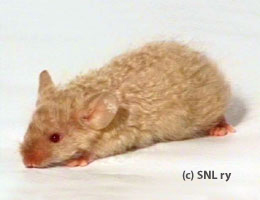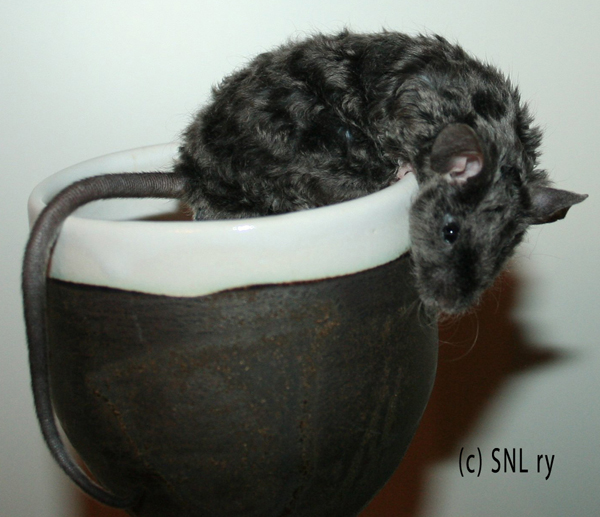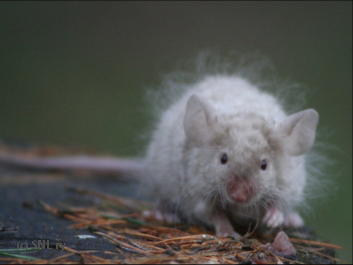Varieties
Coats
Astrex (A)
(short hair astrex = sha, short hair satin astrex = shsa, long hair astrex = lha, long hair satin astrex = lhsa etc)
Go/* Re/* sa/sa
(Other curly coat genotypes besides Re/*: dominant Caracul, Ca/* and recessives fuzzy, fz/fz and frizzy, fr/fr. This text refers to Re/*.)
"Coat to be as curly as possible. Whiskers curly. The mouse's coat straightens somewhat as the mouse ages." (Standards for Astrex.)
Breeding information below the pictures.
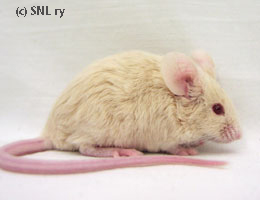
|
SHA Cream doe Rapunzel's Sanctuary |
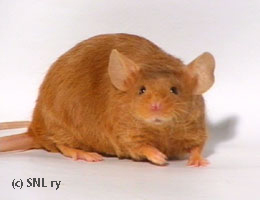
|
SHA Red doe Knuspergardens Hippy Shake This older female has lost some of the curliness. |
Quick Look
Of all curly coated breeds, Short Hair Astrex is the rarest in shows and by far the most difficult to breed right. The ideal SHA would have a distinctively short and curly coat. In reality, most SHA mice look more like shaggy short hairs. Fuzzy is dealt elsewhere as its own coat variety. See provisional standards.
Genetic Background
Genotype of an Astrex mouse is Re/*. The scientific name of the locus in question is "rex" and the symbol is "Re". This dominant gene is a spontaneous mutation and it is located in chromosome 11. Being dominant, both Re/re and Re/Re produces curly coat. However, homozygous mice show more curl, especially youngsters. The coat gradually straightens with age, while whiskers and guard hairs remain wavy.
Mice have several curly coat genes, with differing effects. What is available to a mouse fancier varies from one location to another.
In More Practical Terms...
The major problem with breeding short hair astrex mice is the tendency of the coat to straighten as the mouse ages. At its worse, this means the mouse has lost all distinctive curls / waves when it gets old enough to attend the first shows (in Finland, the mouse has to be 2 months or over). Astrexes can also lack in type and size.
Astrex mice are best bred as their own line along with a line of Short Hair mice specially bred with Short Hair Astrexes. This helps to build the proper modifiers so that the coat gets curlier after a few generations and the curls last longer. Unfortunately one can't really keep a "pure" Astrex-line with the Re-gene, as continuous Astrex to Astrex matings tend to make the coat sparse.
Astrex looks better on satin than without satin, so SHAs have never as good a curl as SHSAs. This is because the hollow satin hairs are soften and thus the coat gets curlier. With breeding Astrexes, one should note that there are reports on longer Re/* x Re/* -breeding causing sparser hair, so this is something to look out for. Being dominant, one does not need Astrexes to be homozygous (Re/Re) and mice with sparse coat can be left out of breeding.
As with all other varieties, with Astrex the key words are Planned breeding aiming to a set Goal. Always bear in mind that the fancy mouse is an "entirety" - breeding for a certain quality does not mean that you can forget the health, tractability, size and type of the mouse!
When it comes to varieties, a breeder who wants to be able to concentrate on the best possible coat, might want to breed astrexes in Pink Eyed White. Of course, in practice there are only few breeders who choose this option, and there's nothing inherently wrong with that decision - there's simply more to look out for in selective breeding. However, some varieties are quite difficult to get right with astrex coat, others downright suffer from the curliness.
Self varieties keep their looks on curly coat the best. With almost all other varieties the curly coat tends to make the colour appear to be poorer than it is in reality. For example, with the ticked varieties, curls cause the undercolour to show through strongly enough to make the mouse look ?messy?. Of course, the judges should be able to take into consideration the effect of the coat variety on any given colour.
Caracul
Caracul is a gene (locus...) with 16 alleles (genes...) situated in chromosome 15. The official name of this gene is "keratin 71" and symbol "Krt71". The one allele available within the mouse fancy is "Krt71Cav, caracul. Even though the gene is a semidominant, both homozygous and heterozygous forms look alike.
Alone, without other curly coat genes present, caracul produces poor curls. Young caracul mice have wavy coat and curved whiskers, but the waves begin to straighten already at four weeks of age. Adult caraculs look "plushy". Characteristic feature for caracul is a "kink" at the tip of the hair.
While caracul alone gets you nowhere, combined with Re it gives you something to work with. Apparently, it works as a counter-active agent to Re:s tendency of producing sparser coat and adds a little to the overall curliness of the coat. As Ca softens the coat somewhat, it helps the curls brought on by Re to show a little better as well.
Other Curly Coat Genes?
- fuzzy (fz), spontaneous recessive, chromosome 1. fz produces thin, but very curly coat, that gets thicker and curlier with each successive moult.
- frizzy (fr), spontaneous recessive, chromosome 7. The coat starts out as short and rough, turning into short and sparse on older mice.
- Caracul-like (cal). Spontaneous dominant, chromosome 15. As the name suggests, the gene acts like caracul; youngsters are curly, but the coat looks almost completely straight by eight weeks of age.
- Caracul-like 2, Caracul-like 7 (Cal2, Cal7). Six genes situated in chromosome 15, all resembling caracul-like in action. Some of these genes produce coats that keep their curls longer than others. Cal7 differs from the rest by lightening the colour of eyes, ears, feet, tail and coat as well.
- crimpy (cpy). Spontaneous recessive, chromosome 15. Homozygotes have wavy, plushy looking coat and wavy whisers. No information on how well the coat keeps was available at the time of writing.
Short Hair Satin Astrex (shsa)
Go/* Re/* sa/sa
(Other curly coat genotypes besides Re/*: dominant Caracul, Ca/* and recessives fuzzy, fz/fz and frizzy, fr/fr. This text refers to Re/*.)
"Coat to be as curly as possible. Whiskers curly. The mouse's coat straightens somewhat as the mouse ages." (Standards for Astrex.)
"High sheen coat with a satin-like or metallic gloss. White to be known as Ivory and to be as white as possible." (Standards for Satin.)
Breeding information below the pictures.
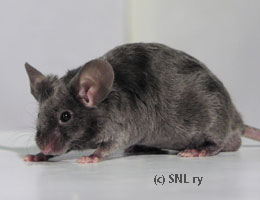
|
SHSA Blue buck Siimis Mustafa |
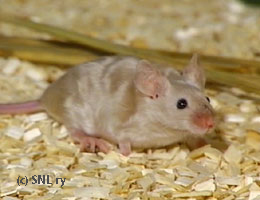 |
SHSA Colorpoint Beige doe Fenkoli |
Quick Look
Compared to Short Hair Astrex, the Short Hair Satin Astrex is slightly easier to breed to standards. This is due to the hollow satin hair curling easier than non-satin hair. The Short Hair Satin Astrex does share problems with the short hair astrex: the straightening of coat and the tendency to lack in type and size (often the side-effect of breeding for coat more than other qualities).
Genetic Background
Short Hair Satin Astrex mice have:
- sa/sa, making them satin instead of non-satin; and
- Re/*, making them curly instead of straight.
In More Practical Terms...
For the best coats it's advicable to breed SHSA to SHSA, or SHSA with SHA. This helps building the correct modifiers in order to get the coat as good as possible. Remember to keep Astrex-bred Short Hair Satins around so as not to end up with thin coated mice.
Long Hair Astrex (LHA)
go/go re/re Sa/* (for 'shorter' long coat)
goY/goYre/re Sa/* (for longer long coat)
(Other curly coat genotypes besides Re/*: dominant Caracul, Ca/* and recessives crimpy, cpy/cpy, fuzzy, fz/fz and frizzy, fr/fr. This text refers to Re/*.)
"Coat to be as long and dense as possible, silky in texture. Bucks have usually longer coat than does." (Standards for Long Hair.)
"Coat to be as curly as possible. Whiskers curly. The mouse's coat straightens somewhat as the mouse ages." (Standards for Astrex.)
Breeding information below the pictures.
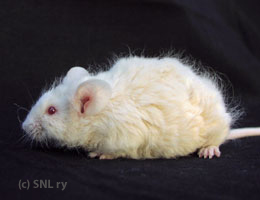
|
LHA Cream buck Carvacasa The coat of this mouse could be both longer and curlier. |
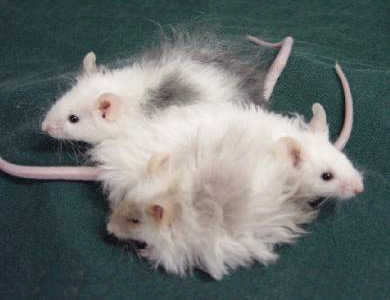
|
Australian LHA mice Pipsqueeks Nimbus, Zirconia & Stargazer Excellent length, curls could be tighter. |
Quick Look
The Long Hair Astrex mouse is a somewhat more familiar sight in shows than Short Hair Astrex, but not nearly as popular as Long Hair Satin Astrex. An ideal LHA mouse would have a dense, long and clearly curly coat. In reality, many tend to lack in both length and curliness of the coat.
For more information, please do read the articles about Long Hair and Short Hair Astrex as well. As you can see from the images above, the coats of two LHA mice can have drastically different lengths. The Long Hair article gives information on the reasons for such a notable difference.
Genetic Background
Long Hair Astrex mice have:
- go/go (or goY/*), making them long hair instead of short hair and
- Re/*, making them curly instead of straight.
In More Practical Terms...
The Long Hair Astrex is a somewhat easier variety to breed into standards when it comes to the curls than the short hair Astrex. This is because the longer hair curls more easily than short hair. In other words, there is more space for the hair to curl. However, getting not only the proper curls and properly long coat on the same mouse can be rather tricky. So, this isn't exactly the most numerous variety on the show bench.
With Long Hair Astrex mice, the over-all appearance and the over-all length of the coat consists of guard hairs (the longest hairs on the mouse's coat) and the undercoat, with the curls giving the mouse its distinctive look. The length and density of both layers of coat are very important, as is the quality of the curls. One should try to breed for a coat that not only is long and curly, but stays like that.
If one forgoes the type and size (and the quality of colour/markings variety), it is easier to get the desired coat. However, although some lacking of size and type can be allowed for a good Long Hair Astrex in shows, these qualities should not be neglected.
The varieties that work the best in Long Hair Astrex are those with the most uniform colouring throughout the coat of the mouse and the single hairs of the coat. That is, self colours (with the slight exception of Silver - due to the blueish undercolour). Ticked colours tend to have problems with the undercolour running too high up the hair, which the curliness shows even more. Markings can have problems with the sharpness of the demarcation lines of the coat as well.
Long Hair Satin Astrex (LHSA)
go/go Re/* sa/sa (for "shorter" long coat)
goY/goY Re/* sa/sa (for longer long coat
(Other curly coat genotypes besides Re/*: dominant Caracul, Ca/* and recessives crimpy, cpy/cpy, fuzzy, fz/fz and frizzy, fr/fr. This text refers to Re/*.)
"Coat to be as long and dense as possible, silky in texture. Bucks have usually longer coat than does." (Standards for Long Hair.)
"High sheen coat with a satin-like or metallic gloss. White to be known as Ivory and to be as white as possible." (Standards for Satin.)
"Coat to be as curly as possible. Whiskers curly. The mouse's coat straightens somewhat as the mouse ages." (Standards for Astrex.)
Breeding information below the pictures.
Quick Look
Of all the four Astrex varieties (Short Hair Astrex, Short Hair Satin Astrex, Long Hair Astrex and Long Hair Satin Astrex), this tends to be the easiest to breed to meet the standards. This is because the longer hair gives the curls more space to curl and show the curls, and the hollow satin hair curls easier than non-satin hair.
Genetic Background
Long Hair Satin Astrex mice have:
- go/go (or goY/*), making them long hair instead of short hair;
- sa/sa, making them satin instead of non-satin; and
- Re/*, making them curly instead of straight.
In More Practical Terms...
In order to get the best coats, the combination to go for is LHSA to another LHSA, or LHA, striving for a coat that keeps its length and curls as long as possible. Remember to keep Astrex-bred Long Hair Satins around so as not to end up with thin coated mice.

